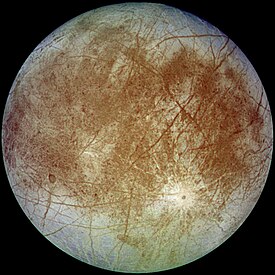Where in the solar system is the most viable place to put my colonists, after Mars and Luna?
Mars and Earth's moon already feature in a lot of fiction about space colonization. After these two planets, and assuming that other solar systems are too far away, what is the best place within this solar system to colonize?
This post was sourced from https://worldbuilding.stackexchange.com/q/2507. It is licensed under CC BY-SA 3.0.
2 answers
Habitability
For a cosmic body to be habitable by humans, it needs to have a few things (or substitutes for those things):
- Oxygen
- Water
- Correct temperature
- Food source
Some of those we can bring with us (like some food and some water) but we won't be able to send enough supply ships to sustain a colony. Ideally, there should be some there already.
Temperature is a little different. We can affect it, but it's not easy. The easiest thing to do would be to find a planet in the Goldilocks (habitable) zone, which, for Sol, looks like this:
It seems that no other planet is in Sol's habitable zone. However, since we can affect the temperature of a planet, we can use those on either side of the zone.
Candidate 1: Venus
Is not that great for colonizing at the moment. Its atmosphere is 96% CO2; the temperature at the surface is 735K; and the atmospheric pressure is 92 times Earth's. However, it could be made habitable.
-
Remove CO2.
This both reduces atmospheric pressure since there isn't so much gas in the atmosphere, and reduces temperature by removing greenhouse gas that keeps it hot. This is by far the biggest job: you want to remove CO2 until the atmospheric pressure is about 0.79atm. -
Add oxygen.
This makes it livable for us, as well as adding some more cooling effect.
For added bonus, you could remove the sulfur dioxide clouds in the atmosphere, which would lower acid rain levels once you add water. Don't forget the water.
Candidate 2: Asteroid Belt
This could be viable. The optimum here would be to make lots of smaller colonies on separate asteroids and develop asteroid-hopping ships to share resources. The asteroids have:
- Minerals
- Water (mostly ice)
- Reasonable temperatures
They do not have:
- Atmospheres
- Gravity
- Oxygen
Your colonists would need to build airtight, pressurised, oxygenated domes to live in, and they might well want to add some kind of artificial gravity. Other than that, this is a good target.
Candidate 3: Europa
The Wikipedia summary image captures why Europa is a good target quite well:

Europa's trailing hemisphere in approximate natural color. The prominent crater in the lower right is Pwyll and the darker regions are areas where Europa's primarily water [and] ice surface has a higher mineral content. Imaged on 7 September 1996 by Galileo spacecraft.
From that we can straight away tell that Europa has:
- Minerals
- Water (partially ice)
- Low (or no) atmosphere (implied by the impact crater - bodies with atmospheres are less likely to be struck)
This is already good. All your colonists need now is artificial gravity and a sealed oxygenated dome to live in. As others have said, it is still possible to collect Solar power on Europa.
Choice
Out of the three candidates, I pick this order:
- Europa
- Asteroid belt
- Venus
Europa wins because it takes the least amount of effort to make habitable and has most of the resources we need there already. The asteroid belt is not far behind, given that it has quite a lot of resources, but it takes more effort to set up and there is a higher risk of collision. Venus is a lot of effort to get to a livable state, so I would only send colonists there after a lot of work.
0 comment threads
My choices: Ganymede and Callisto (and maybe Titan)
This is perhaps a bit of a buzzkill, but I honestly would not recommend colonizing much in the solar system besides the Moon and Mars. Here's why I would take a lot of bodies off the table:
- Mercury - Too hot on its sunny side for colonization (up to 700K) and too cold on its dark side (down to 100K). Solar power on its sunny side would be tricky as parts of the solar array could melt. Also not too special resources-wise.
- Venus - Generally a hellish place to be. High atmospheric pressure means spacecraft can (and have been) completely crushed. A runaway greenhouse effect means temperatures are extremely high (737 K), and clouds of sulfuric acid make rainy days pretty bad.
- Asteroid Belt - A lot of small bodies. Hard to track smaller asteroids because of the concentration. Not a lot of collisions, but there's always the possibility. Low-gravity means that you won't have a substitute for terra firma anywhere.
- Jupiter - obviously not a good place to land a spacecraft. Fairly far away, which means that "Houston, we have [had] a problem" will go unheard for a couple minutes. The one thing in its favor is that many of its moons are fairly large. From here on out, solar power becomes less feasible.
- Saturn - Same issues as Jupiter. This would actually be, in my opinion, the best of the bunch, because you could find raw materials in its rings. It, too, has a lot of moons, but they really aren't big enough to support a proper colony.
- Uranus - same issues as Jupiter. Also, we the voyage here would take a long time.
- Neptune - same issues as Uranus.
- Beyond - You have the Kuiper Belt and the Oort Cloud as you get beyond Neptune. There are lot of small, rocky and icy bodies here, such as comets, and a few dwarf planets. Again, travel time and communication time are issues, and there's not a lot of gravity to make a large-scale colony. You could get some water here, but it would be in the form of ice. There could also be minerals, but, once again, it's pretty far away. Its cousin, the asteroid belt, is a better option.
Here's why the Moon and Mars are much better targets:
- The Moon - Very close to home. Easy to get to and easy to send messages to. We've already been there, and have proven we can land there and even drive around.
- Mars - Not too far away. We've sent a lot of landers there. Good gravity, so it would be easy to adapt to. Terraforming is also an option.
The Moons
You can thank durron597 and cHao for this little section. I did not address the moons of the solar system in my answer - in fact, I may have unfairly written them off - and so I'll add a little bit about them here.
- Moons of Mars - Mars has two moons, Deimos and Phobos. They're fairly small, and are most likely former asteroids. I hope we can all agree that they're not fantastic targets for colonization - in fact, Phobos is expected to enter Mars' Roche limit at some time in the far future, and be broken into a small ring. This of course doesn't stop near-term colonization. Their size is an issue, though.
- Moons of Jupiter - Jupiter has at least 67 moons, the most of any planet in the solar system. The biggest four are the Galilean moons - Io, Europa, Ganymede, and Callisto. They rival (or surpass) Mercury in size. Europa is famous for its icy oceans, and has been considered (by others in this question) as a good place to colonize. I would put that destination on hold until we know more about it, but it has merit. Io has many volcanoes, which could prove detrimental to any intrepid Jovian lunar explorers. Ganymede is larger than Mercury (good) but is much less massive (bad). This might be the most promising of all the Jovian moons, especially since it has a thin atmosphere of oxygen. It also has a magnetosphere. It would be one of my two picks to colonize. That said, Callisto also has some promise. It has a thin atmosphere and is about the size of Mercury - though much less massive. It has also been well-explored, and has water on the form of ice. Therefore, I would nominate it, alongside Ganymede, for a target of human colonization.
- Moons of Saturn - Saturn has 62 moons, the most famous of which is Titan. Like Ganymede and Callisto, it is about the size of Mercury, but, like them, is much less massive. It has hydrocarbon lakes and a nitrogen atmosphere. It does have some water ice but also rains of methane. It could supported life in the past (or could now), but any such creatures would have different metabolisms than us, and be based on different chemicals. I wouldn't rule out Titan as a target, but its methane lakes worry me a little. The nitrogen atmosphere is really good, though. Saturn's other moons are less prominent, although not to be ignored. The ring system could also be a decent target. I'd rank Titan as my third choice, after Ganymede and Callisto.
- Moons of Uranus - Uranus has a measly 27 moons, most of which are named after Shakespearean characters. Most are much smaller than Earth's moon. Many may have water in the form of ice buried inside them. The downside to colonizing Uranian moons is the travel time - it would take years to get to Uranus. But again, the ring system could provide some good materials.
- Moons of Neptune - Neptune's 14 moons are, like Neptune, fairly far away. Once again, we have the travel/communication problem. Triton, the largest, most likely has a lot of water - again, in the form of ice. It also has nitrogen, although its atmosphere is much less dense than Earth.






















0 comment threads